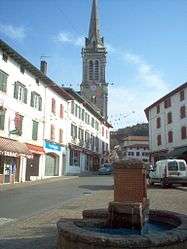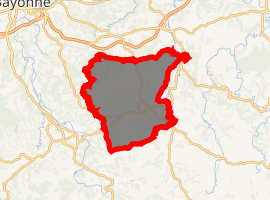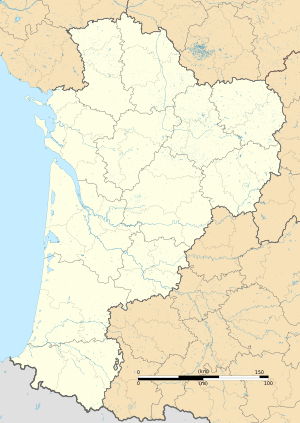Hasparren
Hasparren (Basque: Hazparne) is a commune in the Pyrénées-Atlantiques department in south-western France. A resident of Hasparren is known as a 'Hazpandar'.
Hasparren Hazparne | |
|---|---|
 The church of Saint Jean-Baptiste and surroundings | |
.svg.png) Coat of arms | |
Location of Hasparren 
| |
 Hasparren  Hasparren | |
| Coordinates: 43°23′08″N 1°18′13″W | |
| Country | France |
| Region | Nouvelle-Aquitaine |
| Department | Pyrénées-Atlantiques |
| Arrondissement | Bayonne |
| Canton | Baïgura et Mondarrain |
| Intercommunality | CA Pays Basque |
| Government | |
| • Mayor (2008–2014) | Beñat Inchauspé |
| Area 1 | 77.01 km2 (29.73 sq mi) |
| Population (2017-01-01)[1] | 6,879 |
| • Density | 89/km2 (230/sq mi) |
| Time zone | UTC+01:00 (CET) |
| • Summer (DST) | UTC+02:00 (CEST) |
| INSEE/Postal code | 64256 /64240 |
| Elevation | 7–610 m (23–2,001 ft) (avg. 89 m or 292 ft) |
| 1 French Land Register data, which excludes lakes, ponds, glaciers > 1 km2 (0.386 sq mi or 247 acres) and river estuaries. | |
Geography
Location
Its a commune fait partie of the Basque Province of Labourd.
The Côte Basque (Euskal Kostaldea), is 25 km to the west.
Access
Hasparren is located on the route D 10, between La Bastide-Clairence and Cambo-les-Bains, at the crossroads with D 21, D 22 and D 23. It has got access to autoroute A 64, exit 4 near Briscous.
Hydrography
The lands of the commune are rooted[2] in the affluents of the Adour, the Ardanabia[3] (and by its tributaries the Angelu and the ur Handia) and the Aran (and by its tributary le Marmareko erreka)
Locations
Eight towns compose the Cummune of Hasparren:[4]
- Labiri 43.38516°N 1.32767°W ;
- Elizaberri 43.39157°N 1.32372°W ;
- la Coste (la Côte sur les cartes IGN) 43.40488°N 1.28398°W ;
- Peña (Pegna sur les cartes IGN) 43.40544°N 1.30036°W ;
- Minhotz 43.38975°N 1.29184°W ;
- la Ville ;
- Urcuray 43.36747°N 1.35465°W ;
- Bas-Labiri et Zelhaia 43.36438°N 1.31385°W .
Toponymy
Ancient attestations
It is attestested[5] with various words: Hesperenne (1247 in Cartulaire de Bayonne[6]) Santus Johannes de Ahesparren, Hesparren und Haesparren (the former two 1255 and 1288 in Chapitre de Bayonne[7]), Ahezparenne (1288, Rôles Gascons), Esparren (1310, Cartulaire de Bayonne[6]) Aezparren, Hesperren, Hasparrem and Hesparrem (1348 both in Chapitre de Bayonne[7]), Hasparn and Haspar (1686 and 1754, Collations du Diocèse de Bayonne[8]), Hasparre (A map of the Basque Lands) and Hazparne (19th century).
Etymology
The toponyme Hasparren derives from the ancient Ahaitz-barren(a) > Ahaizparren(a), a composition of the Basque root ahaitz that indicates a height and barren (the interior)[9] - and not form "Haritz barne" (Inner Oak) as the local tradition says.
Other toponymes
The toponyme Elizaberri appears with the from Éliçaberria (1863, dictionnaire topographique Béarn-Pays basque[5]).
The toponyme Urcuray appears[5] with the form Saint-Joseph d'Urcuraye (1662, collations du diocèse de Bayonne[8]).
The toponyme Celhay appears[5] with the from Célay (1863, dictionnaire topographique Béarn-Pays basque[5]).
References
- "Populations légales 2017". INSEE. Retrieved 6 January 2020.
- "Site du Sandre sur Hasparren". Archived from the original on 2008-02-20. Retrieved 2019-03-15.
- L'Ardanabia est notée 'Ardanavy' par le Sandre.
- Généalogie et Histoire des Familles (1835). "Cadastre napoléonien Labourd / Hasparren". Retrieved 26 August 2018.
- Raymond, Paul (1863). Dictionnaire topographique du département des Basses-Pyrénées (in French). Imprimerie Impériale.
- Cartulaire de Bayonne ou Livre d'Or - Manuscrit du XIVe siècle.
- Chapitre de Bayonne - Archives départementales des Pyrénées-Atlantiques
- Manuscrits du XVIIe et du XVIIIe siècles
- Jean-Baptiste., Orpustan (2006). Nouvelle toponymie basque : noms des pays, vallées, communes et hameaux historiques de Labourd, Basse-Navarre et Soule (Éd. entièrement rev. et corr ed.). Pessac: Presses universitaires de Bordeaux. ISBN 2867813964. OCLC 72757865.
- Euskaltzaindia - Academy of the Basque language
